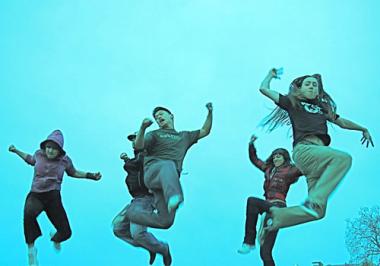The 1957 Broadway debut and the 1961 version of West Side Story featured explosive, athletic ballet, choreographed by Jerome Robbins, who had the initial idea for the musical. Drawing inspiration from Robbins, break dancing, crumping and capoeira, choreographer Maura Nguyen Donohue gave West Side Story a facelift, ditching ballet for battles.
"I love Jerome Robbins," said Donohue. "I'm never going to say there's something wrong with Robbins, and the way he was able to represent tension using ballet. … But he had classically trained dancers who were being asked to play tough, whereas we have some seriously tough guys in this show. That represents a more truly contemporary urban aesthetic."
Donohue chose to incorporate contemporary hip-hop dance forms such as crumping and break dancing, and the Brazilian martial art capoeira. All three forms represent a kind of battle.
"Crumping originated in south L.A.," said Donohue. "It grew out of the community there as a result of the post-Rodney King/L.A. riots landscape. It's really about trying to find a way to move expressions of rage and frustration into physical forms instead of violence."
Crumping is a energetic improvisational dance characterized by fast, furious moves. Although crumping as an art form was created as an antidote to the commercialization of hip-hop, according to Donohue, the art form has spread across the country and is gaining notoriety.
"This particular style is really interesting to me, especially the notion of battling, which is the same original impetus that break dancing grew out of," said Donohue. Dancers who crump belong to "families," which battle other "families" through dance.
While it seems a fairly obvious choice to include break dancing in a contemporary hip-hop adaptation of West Side Story, the reasons Donohue included capoeira are a little less apparent. The Brazilian dance is a form of martial arts that most believe was created by weaponless and often bound Brazilian slaves in the 17th century. Capoeira features moves that are believed to represent the range of motion available to those fighting bound and weaponless. This dance takes place with dancers paired face to face, one on one.
"Capoeira fed break dancing," said Donohue. "A few decades ago, you had black kids in the Bronx sitting next to some Brazilian kids practicing capoeira. You can actually see a lot of moves from that style show up in break dancing."
One major difference between the styles is that instead of one-on-one capoeira battles, break dancing battles take place inside a "cipher"—a circle break dancers form around the individual dancer performing.
Although a lot of the dance in this adaptation is choreographed, a major portion is improvisational, true to the natures of crumping, break dancing and capoeira.
"I wouldn't want to tell them what to do while they're improvising," said Donohue. "That would be killing the form—it's all about dancers being able to express themselves individually as much as possible."



